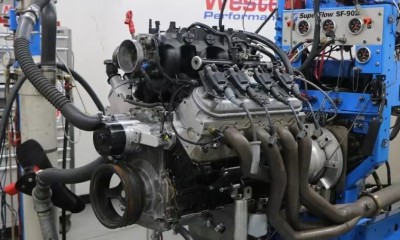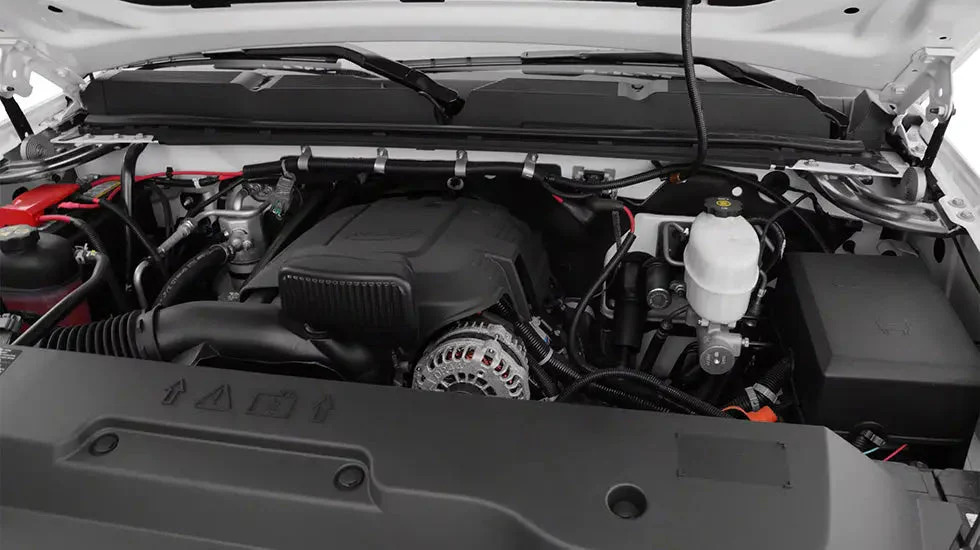Chevrolet 4.8L V8 Engine: The Ultimate Tuning and Performance Guide

In the pantheon of General Motors' legendary LS-based V8 engines, the larger 5.3L, 6.0L, and 6.2L variants often steal the spotlight. However, for professional tuners and performance enthusiasts with a keen eye for value, the Chevrolet 4.8L V8 also known as the Vortec 4800 stands out as a true unsung hero. Often overlooked due to its smaller displacement, this engine has cultivated a dedicated following as the ultimate "budget hero," offering a potent combination of durability, availability, and staggering tuning potential.
The core of the 4.8L's appeal lies in its exceptional cost-to-performance ratio. As the smallest member of the LS truck engine family, it is widely available and remarkably affordable in the second-hand market, frequently sourced from salvage yards. This accessibility dramatically lowers the financial barrier to entry for high-horsepower projects. The engine's robust cast-iron block provides a nearly indestructible foundation, particularly for forced induction applications where it can reliably handle immense power levels.
This unique combination of low cost and high strength creates an ideal platform for tuners to experiment with aggressive setups without the financial risk associated with more expensive, exotic engines. The journey from a humble work-truck motor to a high-performance powerhouse is not only possible but surprisingly straightforward. With basic bolt-on modifications and a professional ECU tune, a 4.8L V8 can easily achieve 400 horsepower. When forced induction is introduced, those numbers can skyrocket, with properly supported builds exceeding 1,000 horsepower on a stock bottom end. This guide will provide a comprehensive, data-driven exploration of how to unlock that incredible potential.
A Legacy of Power: Generations and Variants of the 4.8L V8
To effectively tune the 4.8L V8, it is crucial to understand that not all versions are created equal. The engine evolved across two major generations of GM's small-block architecture Gen III and Gen IV with significant changes to its electronics and internal components. Identifying the specific variant is the first and most critical step in selecting the correct hardware and, most importantly, the appropriate ECU tuning file.
Read More: Nissan Patrol 2024 ECU Tuning
The Gen III LR4 (1999-2006): The Foundation
The LR4 was the inaugural 4.8L V8, introduced as a cornerstone of the Gen III Vortec engine family. It established the engine's reputation for reliability and served as the workhorse in countless GM trucks and vans. 
-
Key Identifiers: The Gen III LR4 is characterized by its iron block, cathedral port aluminum cylinder heads (castings 862 or 706), a 3-bolt camshaft gear, and a 24x crankshaft reluctor wheel. The engine management system is controlled by the Warren Powertrain Control Module (PCM). A notable transition occurred during its production run, with early models (1999-2002) using a drive-by-cable throttle body, while later models (2003-2006) phased in an electronic drive-by-wire system.
-
Vehicle Applications: The LR4 was widely used in the Chevrolet Silverado 1500, GMC Sierra 1500, Chevrolet Tahoe, GMC Yukon, and the Chevrolet Express and GMC Savana vans.
The Gen IV LY2 (2007-2009): A Step Up in Performance
The LY2 marked the 4.8L's entry into the more advanced Gen IV architecture, bringing with it several key internal and electronic upgrades that enhanced its performance potential.
-
Key Identifiers: The LY2 is distinguished by its stronger Gen IV connecting rods, flat-top pistons with integrated valve reliefs, and a move to a 58x crankshaft reluctor wheel. The camshaft position sensor was also relocated to the front of the engine. Critically, the LY2 did not feature Active Fuel Management (AFM) or Variable Valve Timing (VVT), making it a desirable choice for its simplicity and robustness in tuning and engine swap projects. It is controlled by the more powerful E38 PCM.
-
Vehicle Applications: This engine was fitted in the 2007-2009 model year Chevrolet Silverado, Tahoe, GMC Sierra, Yukon, and the 2008-2009 Express and Savana vans.
You May Like: Pontiac Grand Prix Tuning Guide L67 V6 LS4 V8 Performance
The Gen IV L20 (2010-2017): Modern Refinements
The L20 represents the final and most technologically advanced iteration of the Vortec 4800, incorporating modern features to improve efficiency and flexibility.
-
Key Identifiers: The L20 retained the Gen IV's 58x reluctor wheel and robust bottom end but introduced two significant technologies: Variable Valve Timing (VVT) and Flex Fuel (E85) capability from the factory. The inclusion of VVT requires specific considerations during ECU tuning to optimize its benefits. Like the LY2, the L20 was not equipped with the often-deleted AFM system.
-
Vehicle Applications: The L20 was the standard V8 in later model Chevrolet Silverado, GMC Sierra, Chevrolet Express, and GMC Savana vehicles.
A professional workshop receiving a "motor 4.8 chevrolet" for tuning must first determine which of these three distinct electronic and mechanical platforms they are working with. Asking the customer for the vehicle's model year and the 8th digit of the VIN allows for instant identification using the table below. This crucial first step prevents ordering an incompatible ECU file, saving time, avoiding frustration, and ensuring a successful tuning outcome.
|
Engine Code |
Generation |
Production Years |
VIN (8th Digit) |
Block Material |
Reluctor Wheel |
VVT |
AFM |
Flex Fuel |
Stock Power / Torque |
Key Identifier |
|
LR4 |
Gen III |
1999–2006 |
V |
Iron |
24x |
No |
No |
No |
255-285 hp / 285-295 lb-ft |
Rear Cam Sensor, 3-Bolt Cam |
|
LY2 |
Gen IV |
2007–2009 |
C |
Iron |
58x |
No |
No |
No |
260-295 hp / 295-305 lb-ft |
Front Cam Sensor, No VVT |
|
L20 |
Gen IV |
2010–2017 |
A |
Iron |
58x |
Yes |
No |
Yes |
285-302 hp / 295 lb-ft |
Front Cam Sensor, Has VVT |
Engineering Deep Dive: Core Architecture and Specifications
The Chevrolet 4.8L V8's immense tuning potential is rooted in its robust and well-engineered mechanical design. It shares the same foundational architecture that has made the entire LS engine family a dominant force in the performance world for decades. Understanding these core components reveals why this "small" V8 can handle such extraordinary power levels.
The Foundation: Iron Block and 6-Bolt Main Caps
The bedrock of the 4.8L's strength is its cast iron cylinder block. While heavier than the aluminum blocks used in some performance cars, the iron construction provides superior cylinder wall rigidity and strength, making it exceptionally resistant to the high cylinder pressures associated with forced induction. This is a primary reason why the 4.8L is a favorite for high-boost turbo builds.
This strength is further enhanced by the signature LS deep-skirt block design, where the block casting extends well below the crankshaft centerline. This allows for the use of six-bolt main bearing caps (four vertical bolts and two horizontal cross-bolts), which securely clamp the crankshaft in place, providing incredible bottom-end stability and minimizing flex even at high RPM and power levels.
Breathing Easy: Cylinder Head Design and Airflow
All variants of the 4.8L V8 are equipped with aluminum cylinder heads featuring "cathedral port" intake runners. This port shape is known for promoting high air velocity, which translates to excellent throttle response and strong torque production in the low-to-mid RPM range.
-
Gen III LR4 heads typically carry casting numbers 862 or 706.
-
Gen IV LY2 heads use the 799 casting, which is a significant upgrade. The port design of the 799 head is nearly identical to the highly sought-after 243 casting found on the high-performance LS6 engine, giving the LY2 a distinct airflow advantage from the factory.
The Rotating Assembly: Strength in Simplicity
The internal components of the 4.8L are built for durability. The rotating assembly consists of a cast iron crankshaft, powdered-metal connecting rods, and strong hypereutectic cast aluminum pistons. The key distinction between the 4.8L and its larger 5.3L sibling lies in the crankshaft and pistons. Both engines share the same 3.780-inch bore, but the 4.8L uses a shorter 3.267-inch stroke crankshaft and flat-top pistons. The 5.3L uses a longer 3.622-inch stroke crank and typically has dished pistons. This shorter stroke is what gives the 4.8L its characteristic rev-happy nature and contributes to its durability under high RPM conditions. Furthermore, the Gen IV engines (LY2, L20) were equipped with stronger connecting rods compared to the Gen III LR4, making them even better suited for boosted applications right out of the box.
Read More: Best Chiptuning Software 2025
For engine builders and tuners planning a high-performance build, having precise specifications is not just helpful it's essential. The following table consolidates the critical technical data for each 4.8L variant, providing a single, reliable reference for calculations involving compression ratios, piston-to-valve clearance, and component selection.
|
Specification |
Gen III LR4 (1999-2006) |
Gen IV LY2 (2007-2009) |
Gen IV L20 (2010-2017) |
|
Displacement |
4.8L (293 ci) |
4.8L (293 ci) |
4.8L (293 ci) |
|
Bore x Stroke |
96.01×83.0 mm (3.780 x 3.267 in) |
96.01×83.0 mm (3.780 x 3.267 in) |
96.01×83.0 mm (3.780 x 3.267 in) |
|
Block Material |
Cast Iron |
Cast Iron |
Cast Iron |
|
Head Material |
Aluminum |
Aluminum |
Aluminum |
|
Head Casting # |
862, 706 |
799 |
799 (or similar) |
|
Combustion Chamber Vol. |
≈61 cc |
≈65 cc |
≈65 cc |
|
Compression Ratio |
9.4:1 - 9.5:1 |
9.1:1 |
8.8:1 |
|
Piston Style |
Flat Top |
Flat Top w/ Valve Reliefs |
Flat Top w/ Valve Reliefs |
|
Connecting Rod Length |
6.275 in |
6.275 in |
6.275 in |
|
Stock Cam Specs (Dur/Lift) |
≈191/190∘, 0.457/0.466 in |
≈191/190∘, 0.457/0.466 in |
VVT - Specs Vary |
|
Throttle Body Size |
78 mm (3-Bolt) |
87 mm (4-Bolt) |
87 mm (4-Bolt) |
|
Stock Injector Flow |
21.8 - 25.2 lb/hr |
≈29.6 lb/hr |
≈29.6 lb/hr (Flex Fuel) |
The Key to Unlocking Performance: Professional ECU Tuning
The robust mechanical architecture of the Chevrolet 4.8L V8 provides a platform with immense latent potential. However, this potential remains dormant, locked away behind conservative factory calibrations. The single most effective tool for unlocking this power is professional Engine Control Unit (ECU) remapping. The ECU (or PCM) is the electronic brain of the engine, and modifying its software parameters is the foundational step that enables all other performance upgrades to function safely and effectively.
ECU tuning is not merely a single modification but an enabling technology. Adding a cold air intake allows more air into the engine, but without a tune to add a corresponding amount of fuel, the engine will run lean, increasing the risk of damage and failing to realize the full power gain. Similarly, installing a turbocharger introduces massive volumes of air, but without a sophisticated tune to manage fuel delivery and ignition timing, catastrophic engine failure from detonation is almost guaranteed. Even a camshaft upgrade, which fundamentally alters the engine's breathing characteristics, requires a complete recalibration of the ECU's maps to function correctly. The ECU tune is the master key that harmonizes all hardware changes into a cohesive, powerful, and reliable system.
A professional ECU remap involves the precise adjustment of several key tables within the vehicle's software:
-
Fuel Tables: The air-fuel ratio is meticulously adjusted across the entire RPM and load range to ensure optimal combustion for maximum power, while maintaining safe operating parameters, especially under the high demands of forced induction.
-
Ignition Timing: Spark timing is carefully advanced to increase torque and horsepower. This process is balanced against data from the knock sensors to prevent detonation, which can be destructive to engine internals.
-
Drive-by-Wire (DBW) Control: The stock throttle response on these trucks is often described as numb and delayed. A custom tune recalibrates the relationship between the accelerator pedal and the throttle body, providing a sharper, more immediate, and engaging driving feel.
-
Torque Management: From the factory, the ECU is programmed to limit engine torque under certain conditions to protect the stock transmission and drivetrain components. Professional tuning can reduce or eliminate these limiters, allowing the engine to deliver its full, unrestricted power.
-
RPM and Speed Limiters: The factory-set engine RPM and vehicle speed limiters can be safely raised to allow the engine to operate in its new, higher powerband and achieve greater top speeds.
Crucially, the quality of the tuning file makes all the difference. Generic, "canned" tunes offer a one-size-fits-all approach that cannot account for the unique combination of modifications, fuel quality, and operating conditions of a specific vehicle. In contrast, professionally developed, dyno-tested tuning files, like those provided by HP Chiptuningfiles, are crafted based on real-world data to deliver the maximum safe power for a given hardware setup.
Are you a tuning workshop looking to provide your customers with the best possible results? Create a free account to access our extensive database of custom Chevrolet tuning files and elevate your service offerings.
A Phased Approach to Chevrolet 4.8L V8 Tuning
Modifying the 4.8L V8 can be approached in stages, allowing for a progressive build-up of power that suits different budgets and performance objectives. At every level, a professional ECU tune is the cornerstone that ensures all components work in harmony to deliver safe and reliable power.
Stage 1: Foundational Gains (Up to +50 HP)
This stage focuses on simple, effective bolt-on modifications that enhance the engine's breathing and efficiency, unlocked by a precision ECU remap.
-
ECU Remapping: This is the first and most impactful modification. A Stage 1 tune for a stock or near-stock 4.8L optimizes fuel and ignition for premium fuel, sharpens throttle response, and refines transmission shift points. On its own, a quality tune can deliver gains of 15-30 hp and 15-20 lb-ft of torque, transforming the vehicle's driving dynamics.
-
Improving Airflow:
-
Cold Air Intake (CAI): Replacing the restrictive factory airbox with a high-flow cold air intake system can yield an additional 10-17 hp by providing the engine with a cooler, denser charge of air.
-
Performance Exhaust: A cat-back exhaust system reduces backpressure and improves sound. For maximum gains, long-tube headers are highly effective, freeing up significant power by improving exhaust scavenging from the cylinders.
-
|
Modification |
Typical HP Gain |
Typical Torque Gain |
Estimated Cost (USD) |
Notes |
|
Stage 1 ECU Tune |
+15-30 hp |
+15-20 lb-ft |
$300 - $600 |
Highest return on investment; improves power and drivability. |
|
Cold Air Intake |
+10-17 hp |
+10-18 lb-ft |
$200 - $450 |
Enhances engine breathing and throttle response. |
|
Cat-Back Exhaust |
+5-15 hp |
+5-15 lb-ft |
$500 - $1,200 |
Improves sound and reduces restriction. |
|
Long-Tube Headers |
+20-30 hp |
+20-25 lb-ft |
$400 - $1,500 |
Significant power gains, especially when combined with a tune. |
Stage 2: Advanced Naturally Aspirated Power (400+ HP)
For those seeking to maximize naturally aspirated performance, the next step involves upgrading the engine's core components to process more air and fuel at higher RPMs.
-
Camshaft Selection: A performance camshaft is the heart of any serious N/A build. Swapping the mild factory cam for an aftermarket profile can unleash an additional 65-90+ hp. The choice of cam depends on the goal; "truck cams" are designed to boost mid-range torque for daily driving and towing, while more aggressive cams will shift the powerband higher in the RPM range, which may necessitate a higher-stall torque converter for optimal performance.
-
Valvetrain and Cylinder Head Upgrades: A higher-lift camshaft requires a corresponding upgrade to the valve springs to prevent valve float at high RPM. For enhanced reliability, a rocker arm trunnion upgrade is also highly recommended. To maximize the benefits of the new cam, CNC-porting the stock cylinder heads can significantly improve airflow. A well-executed heads-and-cam package on a 4.8L V8 can produce impressive results, with dyno tests showing outputs as high as
-
474 hp.
Read More: Opel ECU Remap Tuning Guide
Stage 3: The Ultimate Power Adder - Forced Induction (500-1,000+ HP)
This is where the 4.8L V8 truly shines. Its combination of a strong iron block, a rev-happy short-stroke design, and a boost-friendly compression ratio makes it an ideal candidate for forced induction.
-
Turbocharging: This is the most popular and cost-effective path to immense power. The 4.8L responds exceptionally well to boost.
-
Sizing: For a single turbo setup, a 78mm compressor with a 75mm turbine (a "7875") is a popular and effective choice, capable of supporting 600-800 wheel horsepower (WHP) with excellent response. For twin-turbo applications, a pair of smaller
-
62mm or 67mm turbos will provide incredibly fast spooling and massive top-end power.
-
Power Potential: With a proper tune, an intercooler, and E85 fuel, a stock bottom-end 4.8L can reliably handle 11-13 psi of boost, producing over 700 hp. With forged pistons and rods, the engine block is capable of withstanding boost levels that push output beyond
-
1,200 hp.
-
-
Supercharging: For those who prefer a different power delivery, superchargers are also a viable option. Roots-style superchargers provide instantaneous low-end torque, ideal for heavy vehicles, while centrifugal superchargers build boost with RPM, delivering a strong top-end power surge.
-
The Non-Negotiable Tune: Managing forced induction is the ultimate test of an ECU tune. The software must be precisely calibrated to deliver massive amounts of fuel to match the increased airflow, pull ignition timing to prevent engine-destroying detonation, and in some cases, actively control boost pressure. This level of control is non-negotiable for engine longevity and performance, making a professional, custom-developed tuning file an absolute necessity.
Planning a turbo build? Our Chiptuning files are dyno-developed to handle high boost safely. Explore our tuning file database now.
Building a Reliable Powerhouse: Essential Supporting Modifications
Achieving high horsepower from the 4.8L V8 is only half the battle. A successful and reliable performance vehicle is a balanced system. The engine's newfound power must be supported by a drivetrain and fuel system capable of handling the increased stress. Neglecting these areas is a common and costly mistake.
Fortifying the Drivetrain: Upgrading the 4L60E Transmission
The stock 4L60E automatic transmission paired with the 4.8L V8 is, without question, the primary weak link in any high-performance build. While adequate for factory power levels, it is notoriously prone to failure when subjected to the significant torque increases from tuning and forced induction.
-
Common Failure Points: The most frequent points of failure within the 4L60E are the 3-4 clutch pack, which burns out under high torque; the stamped-steel sun shell, which can strip its splines or fracture; the plastic accumulator pistons; and the input drum.
-
Solutions and Upgrades: To build a transmission that can withstand 500+ horsepower, a comprehensive rebuild with upgraded components is essential. Performance rebuild kits from reputable suppliers like Sonnax, Raybestos, and Alto are widely available. Key upgrades include:
-
High-performance friction and steel clutch packs (e.g., Raybestos GPZ, Alto Red Eagle Z-Pak) for the 3-4 gear set.
-
A hardened, reinforced sun shell, often referred to as "The Beast."
-
Billet or heavy-duty servos for increased band-clamping force.
-
An upgraded input drum and sprag assembly.
-
A large external transmission fluid cooler to dissipate the extra heat generated by high power levels.
-
A professional ECU tune complements these mechanical upgrades by recalibrating the transmission control unit (TCU) for firmer, quicker shifts and optimized torque converter lockup strategies, further enhancing both performance and durability.
Fueling the Fire: Injector and Fuel Pump Upgrades
The stock fuel system is designed to meet the demands of a naturally aspirated engine producing under 300 horsepower. When forced induction is added, the demand for fuel increases exponentially, and the factory components quickly become inadequate.
-
Fuel Injectors: The stock 4.8L injectors flow between 25-29 lb/hr, which is insufficient for even mild boost. Upgrading to larger injectors is mandatory. The required size depends on the horsepower target and the type of fuel used E85, for example, requires approximately 30% more fuel flow than gasoline for the same power level. Injectors from brands like Bosch, DeatschWerks, and Fuel Injector Clinic are common choices for high-power LS builds.
-
Fuel Pump: The factory fuel pump cannot supply the volume needed for a boosted engine. It must be replaced with a high-flow aftermarket unit. An in-tank pump with a flow rate of 450 liters per hour (LPH) is a popular and effective solution for supporting up to 800 hp on gasoline.
By proactively addressing the known limitations of the drivetrain and fuel system, tuners can ensure their clients' projects are not only powerful but also reliable. This holistic approach prevents catastrophic failures, leads to greater customer satisfaction, and solidifies a workshop's reputation for building well-engineered performance vehicles.
Why HP Chiptuningfiles is Your Partner in Chevrolet Tuning
Choosing the right tuning partner is as critical as choosing the right mechanical components. For professional workshops and dealers dedicated to delivering exceptional results, HP Chiptuningfiles offers a comprehensive, reliable, and business-focused solution for all your Chevrolet tuning needs.
Our expertise is deeply rooted in the GM LS platform, including all variants of the 4.8L V8, from the Gen III LR4 to the Gen IV L20. We understand the nuances of each system and have developed tuning files that are optimized for performance, reliability, and drivability.
Benefits for Your Business:
-
Quality and Reliability: Gain access to our massive tuning file database, which is filled with thousands of custom, dyno-tested files. Each file is developed and verified by expert engineers to ensure it is safe, effective, and delivers on its performance promises.
-
Comprehensive Support: We provide solutions for every stage of a build. Whether you need a Stage 1 file for a stock truck, a custom tune for a heads-and-cam build, or a sophisticated calibration for a high-boost turbo application, we have you covered. Our files include necessary adjustments for automatic transmissions, ensuring a complete powertrain solution.
-
B2B-Focused Platform: Our services are designed specifically for tuning professionals. We offer competitive pricing through a flexible credit-based system, fast file delivery, and dedicated technical support from our team of experts.
-
Hardware Solutions: Beyond software, we are your source for a wide range of high-quality tuning hardware, providing a one-stop shop for your performance needs.
Ready to elevate your tuning services? Chiptuningfiles today and gain immediate access to Europe's leading tuning file service. For any questions, contact our expert support team.
Frequently Asked Questions (FAQ)
How much boost can a stock 4.8L V8 handle? A stock bottom-end Gen IV 4.8L V8 can reliably handle 10-12 psi of boost. With a proper ECU tune, an efficient intercooler, and high-quality fuel like E85, this can result in 600-700 horsepower. The primary limiting factor on the stock engine is often the piston ring gap, not the inherent strength of the block, crankshaft, or rods. With forged internals, the iron block can support well over 1,000 horsepower.
What is the main difference between the 4.8L and 5.3L V8 for tuning? The main physical differences are the crankshaft, connecting rods, and pistons. The 4.8L has a shorter 3.267-inch stroke and flat-top pistons, while the 5.3L has a longer 3.622-inch stroke and typically uses dished pistons. This makes the 4.8L a higher-revving engine by nature, while the 5.3L produces more low-end torque from the factory. For forced induction builds, the 4.8L's robust design and rev-friendly characteristics make it an excellent, and often more affordable, choice.
Is an ECU tune alone worth it for a stock 4.8L V8? Absolutely. A professional ECU remap is the single best modification for a stock 4.8L V8 in terms of performance gain per dollar. It can add 15-30 horsepower and 15-20 lb-ft of torque, but more importantly, it dramatically improves throttle response, optimizes transmission shift behavior, and creates a much more responsive and enjoyable driving experience.
What are the most common problems when tuning a Chevrolet 4.8L engine? The most common failure point is not the engine itself, which is exceptionally durable. The primary issue is the stock 4L60E automatic transmission, which is not designed to handle the significant increase in torque from tuning, especially with forced induction. Another common problem arises when hardware modifications like a cold air intake or headers are installed without a corresponding ECU tune, which can cause the engine to run lean and risk damage. Using a professional, custom tuning file and upgrading the transmission for high-power builds are the keys to long-term reliability.
Other news and updates

Read more OBD Breakthrough: Tuning Support for the Continental ASG1 ECU in Audi e-tron & Porsche Taycan
The Continental ASG1 ECU used in the Audi e-tron and Porsche Taycan is now fully supported for OBD read/write. This breakthrough allows safe tuning of torque limits, current maps, thermal strategies and pedal response, enabling measurable performance gains whi...
Read more

Read more Stage 1, Stage 2, and Stage 3 Tuning: Which One Is Right for You? | HP Chiptuning Files Europe & UK
Discover the differences between Stage 1, Stage 2, and Stage 3 tuning. Learn which remap is best for your car, driving style, and budget at hp-chiptuningfiles.com.
Read more

Read more Mercedes-AMG G63 2025: ECU Remap & Performance Boost
Hey, we are HP Chiptuningfiles – Europe’s leading ECU tuning file service provider. We deliver custom, dyno-tested tuning files for diesel, petrol & hybrid engines, trusted by 4,000+ clients worldwide. The 2025 Mercedes-AMG G63 combines iconic G-Class ruggedne...
Read more